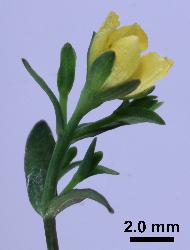- Taxon
- Gallery
Subshrub, rhizomatous. Stems up to 50 mm long, usually prostrate, 0.2–0.3 mm diam., quadrangular, 4-lined, black glands absent. Leaves 1.5–4.5 mm long, 0.3–1.2 mm wide, narrowly elliptic, oblong or lanceolate, glabrous, planar to slightly sinuate, grey-green to olive-green, usually ruddy on margin and distally, abaxially sometimes paler, reticulate tertiary veins absent; pellucid glands present; black glands absent; apex acute to subacute; margin slightly sinuate; base attenuate; sessile. Inflorescence terminal, occasionally axillary, in cymes, flowers usually solitary, sometimes up to 3, corolla 3.0–6.0 mm diam. Pedicels 0.7–1.8 mm. Bracteoles absent. Sepals 4 or 5, 1.7–2.8 mm long, 0.6–1.0 mm wide, unequal widths, oblong to elliptic; pellucid glands present, minute and scattered; black glands absent; apex subacute, apiculus c. 0.1 mm long; margin entire. Petals 2.0–3.3 mm long, 0.9–1.2 mm wide, longer than sepals, elliptic, yellow, black glands absent, persistent after anthesis. Stamens not in bundles, 7 or 9, 1.2–2.0 mm long, shorter than petals; anthers c. 0. 2 mm long, anther gland absent. Ovary 1.4–2.0 mm long, 1.0–1.4 mm wide, ovoid to broadly ovoid. Styles usually 3, occasionally 4, 0.3–0.4 mm long, shorter ovary. Fruit a capsule, 2.3–2.9 mm long, 1.5–2.5 mm wide, cylindric to globose, light brown. Seeds 0.5–0.6 mm long, 0.2–0.3 mm wide, oblong-obovate or oblong, terete, orange brown to light yellow, longitudinal ribs absent or weak, apices obtuse or rounded.
H. minutiflorum is distinguished by an absence of black glands, a rhizomatous and compact growth habit, stems that are usually prostrate or decumbent, leaves that grey-green to olive-green and usually ruddy and without sinuate margins, leaves 1.5–4.5 mm long, flowers less than 6 mm in diam., and seeds usually oblong-obovate. The general size of the vegetative and floral parts of H. minutiflorum is much smaller than H. pusillum and H. rubicundulum (see table of distinguishing characters).
| Character | H. pusillum | H. minutiflorum | H. rubicundulum |
|---|---|---|---|
| Growth habit | not rhizomatous | rhizomatous | rhizomatous |
| Leaves | 2.5-9.0 × 1.5-3.5 mm, usually strongly sinuate, light green to yellow-green | 1.5-4.5 × 0.3-1.2 mm, grey-green to olive-green, usually ruddy on margin and distally | (1.0-)2.5-8.0(-10.0) × 0.5-3.5(-5.5) mm, often slightly sinuate, grey-green to olive-green, often entirely ruddy, particularly on margin and distally |
| Leaf pellucid glands diam. | up to 0.1 mm | up to 0.05 mm | up to 0.05 mm |
| Flower diam. | up to 9 mm | up to 6 mm | up to 11 mm |
| Sepals | 2.8-4.7 × 0.9-1.4 mm | 1.7-2.8 × 0.6-1.0 mm | 2.5-5.0 × 1.0-1.8(-2.3) mm |
| Petals | 2.8-4.0 × 1.7-2.5 mm | 2.0-3.3 × 0.9-1.2 mm | 2.8-5.8 × 2.0-3.5 mm |
| Capsule | 2.8-4.5 × 2.2-3.8 mm | 2.3-2.9 × 1.5-2.5 mm | 2.8-3.5 × 1.5-2.5 mm |
| Seeds | longitudinal ribs absent | longitudinal ribs absent or weak | longitudinal ribs usually distinct |
North Island: Volcanic Plateau, Taranaki (eastern). Restricted to the central North Island Volcanic Plateau and adjoining main axial ranges.
Generally grows in depressions, hollows, or wet ground within frost-flat vegetation, poorly drained tussockland and shrubland, and more rarely on river terraces, tarn or wetland margins.
A putative hybrid between H. minutiflorum and H. pusillum has been collected from Ngamatea East Swamp, Rangitikei River, Volcanic Plateau (CHR 85880).
Flowering: Sep.–Apr.
2n = 16 (de Lange et al. 2004, as H. aff. japonicum (a)).















